Related Research Articles

The Cochin is a breed of large domestic chicken. It derives from large feather-legged chickens brought from China to Europe and North America in the 1840s and 1850s. It is reared principally for exhibition. It was formerly known as Cochin-China.

The Scots Dumpy is a traditional Scottish breed of chicken. It is characterised by very short legs, so short that the body is a few centimetres from the ground; as in other breeds of creeper chicken, this chondrodystrophy is caused by a recessive lethal allele. The Dumpy has at times been known by other names, among them Bakie, Corlaigh, Crawler, Creeper and Stumpy. There are both standard-sized and bantam Scots Dumpies. It is one of two Scottish breeds of chicken, the other being the Scots Grey.
The Taiwanese Game or Taiwan is a breed of large game chicken originating in the island of Taiwan, formerly known as Formosa. It is among the largest of chicken breeds, and may exceed 10 kg in body weight. It shows some similarity to large Japanese Shamo birds and, although it does not originate in Japan, may also be known as the Taiwanese Shamo. Large game chickens of this type but of indeterminate breed may sometimes be marketed as "Taiwan" or – in the United States – as "Saipan", "Saipan Jungle Fowl" or "Chinese Shamo".
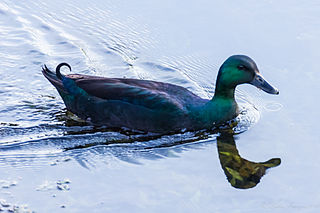
The Cayuga is an American breed of domestic duck. It was introduced to the Finger Lakes region of New York State in about 1840, and is named for the Cayuga people of that area. Until the last years of the nineteenth century it was the principal duck reared for meat in the United States. In the twenty-first century it is kept mainly for ornament. The plumage is black with iridescent beetle-green lights.
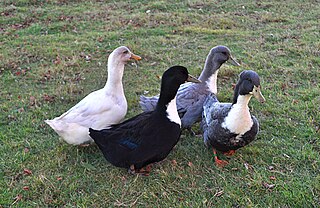
The Swedish Blue or Blue Swedish is a Swedish breed of domestic duck. It originated in the former dominion of Swedish Pomerania – now in north-west Poland and north-east Germany – and is documented there from 1835. It is closely similar to the Pomeranian Duck from the same general area, differing mainly in its white primary feathers.
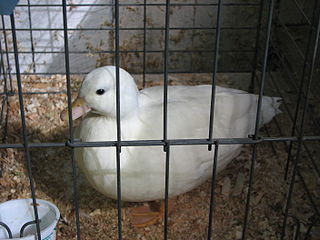
The Call is a historic breed of small domestic duck. It is believed to have originated in the Netherlands, where the earliest descriptions and depictions of it date from the seventeenth century. It is similar in appearance to some other breeds of ducks, but is much smaller, with a round head and very short bill. Female Ducks, but not drakes, are very loquacious and noisy, with a piercing high-pitched call which can be heard from far away.

The Emden or Embden is a German breed of domestic goose. It is named for the town of Emden in north-westernmost Germany.

The New Hampshire Red or New Hampshire is an American breed of chicken. It was developed in the early twentieth century in the state of New Hampshire by selective breeding of Rhode Island Red stock; no other breed was involved. It is fast-growing, early-maturing, quick-feathering, and yields a meaty carcass. Mature birds are a light or medium red in color; they may fade in sunlight.
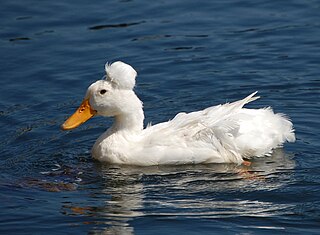
The Crested is a breed of domestic duck. It was probably brought to Europe from the East Indies by Dutch ships. It has its appearance because it is heterozygous for a genetic mutation causing a deformity of the skull.

The Magpie is a British breed of domestic duck. It has distinctive black and white markings reminiscent of the European magpie, and is a good layer of large eggs.

The African or African Goose is a breed of domestic goose. It is one of two domestic breeds that derive from the wild species Anser cygnoides, the other being the Chinese; all other domestic geese derive from Anser anser. Despite the name, it is not from Africa but is of Asiatic origin. It is a large bird, among the heaviest of all goose breeds.

The Crèvecœur is an endangered historic breed of crested chicken from the Pays d'Auge, in the Calvados département of Normandy, in north-western France. It is named after the commune of Crèvecœur-en-Auge. It is related to the La Flèche and to other Norman breeds such as the Caumont and Caux and the extinct Pavilly; the Merlerault was formerly considered a sub-type of the Crèvecœur.

The Modern Game is a British breed of ornamental chicken which originated in England between 1850 and 1900. It was bred from gamecock stock, but solely as an exhibition bird.
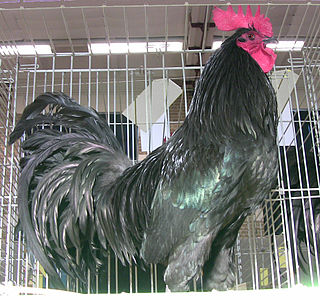
The Tōmaru (唐丸) is a Japanese breed of long-crowing chicken. The crow may be sustained for some 25 seconds. It is one of four Japanese long-crowing breeds, the others being the Koeyoshi, the Kurokashiwa and the Tōtenkō.

The Silver Appleyard is a British breed of domestic duck. It was bred in the first half of the twentieth century by Reginald Appleyard, with the aim of creating a dual-purpose breed that would provide both a good quantity of meat and plenty of eggs.
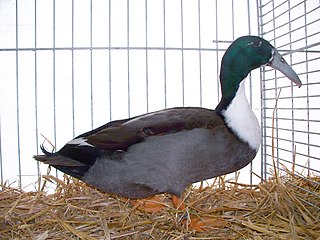
The Hook Bill or Dutch Hookbill is a breed of domestic duck characterised by an unusual down-curved beak. It is an ancient breed, and has been documented since the seventeenth century. Speculation that it originated in Asia, or is related to the Indian Runner, is apparently unsubstantiated.
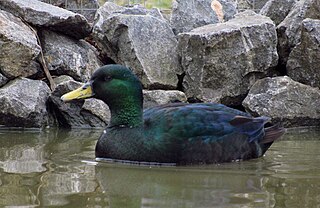
The East Indie or Black East Indian is an ornamental breed of domestic duck. It is a bantam breed, and is thought to have originated in the United States.

The Saxony duck is a German breed of domestic duck. It was bred in Saxony in the 1930s, but because of the Second World War was recognised only in 1957.

The Bresse Gauloise is a French breed of domestic chicken. It originates in the historic region and former province of Bresse, in the regions of Rhône-Alpes, Bourgogne and Franche-Comté, in eastern France. Because of legal restrictions on the use of the name, only white chickens raised within that area may be called "Bresse"; outside it, they are given the name "Gauloise"; the breed name combines both. Four colours are recognised for the Bresse Gauloise, three of them linked to areas within Bresse: the Bresse de Bourg is "grey" (silver-pencilled); the Bresse de Bény is white; the Bresse de Louhans is black; and a blue variety has recently been created. White Bresse de Bény chickens and capons raised in the area of Bresse have appellation d'origine contrôlée status and are marketed as poulet de Bresse; they are regarded as a premium product and command higher prices than other chickens.

The German Pekin, German: Deutsche Pekingente, is a European breed of domestic duck. It is commonly called simply Pekin or White Pekin. It is a different breed from the American Pekin, which is also commonly known by the same names. It was bred in Europe from birds originating in China and Japan and is distributed in many European countries.
References
- ↑ Barbara Rischkowsky, D. Pilling (eds.) (2007). List of breeds documented in the Global Databank for Animal Genetic Resources, annex to The State of the World's Animal Genetic Resources for Food and Agriculture. Rome: Food and Agriculture Organization of the United Nations. ISBN 9789251057629. Accessed January 2017.
- ↑ Breed data sheet: Russkii Tyazhelovoz / Russian Federation (Horse). Domestic Animal Diversity Information System of the Food and Agriculture Organization of the United Nations. Accessed January 2020.
- ↑ Liste des races et variétés homologuée dans les pays EE (28.04.2013). Entente Européenne d’Aviculture et de Cuniculture. Archived 16 June 2013.
- ↑ Ducks. Poultry Club of Great Britain. Archived 9 November 2018.
- 1 2 "Shetland - Duck breed" Britannic Rare Breeds. Retrieved 2014-3-25.
- ↑ "The Shetland Duck". Raising Ducks. 18 April 2019.
- ↑ "Knowledge base".
- 1 2 3 4 5 Shetland. Rare Breeds Survival Trust. Accessed January 2020.
- ↑ Victoria Roberts (2008). British Poultry Standards: complete specifications and judging points of all standardized breeds and varieties of poultry as compiled by the specialist breed clubs and recognised by the Poultry Club of Great Britain, sixth edition. Oxford: Blackwell. ISBN 9781405156424.
- ↑ J. Ian H. Allonby, Philippe B. Wilson (editors) (2018). British Poultry Standards: complete specifications and judging points of all standardized breeds and varieties of poultry as compiled by the specialist breed clubs and recognised by the Poultry Club of Great Britain, seventh edition. Chichester; Hoboken, New Jersey: Wiley Blackwell. ISBN 9781119509141.